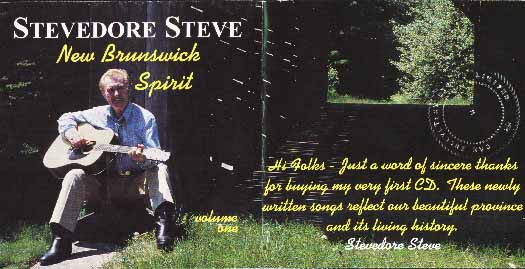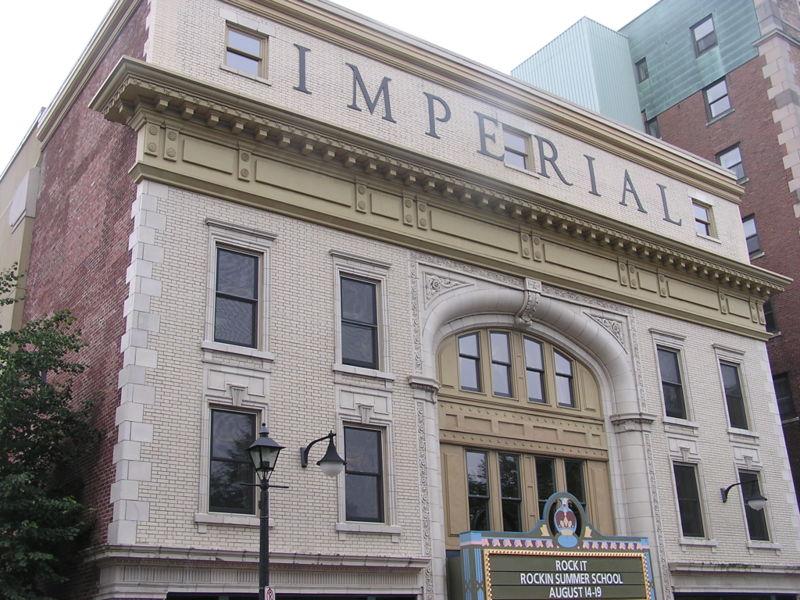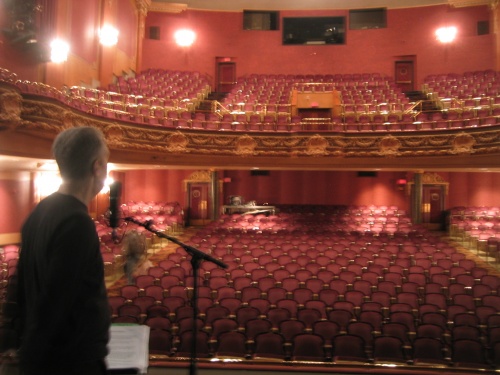
page 12
On The Road Again

Sometimes things happen very mysteriously. No sooner had Stevedore Steve almost given up hope of saving enough money to produce a CD, a silent backer with ideas appeared. The man, David Cole, is a history buff with a special interest on New Brunswick. Inspired by Steve's recent cassettes, he commissioned Steve to write songs that would appear on a CD devoted to New Brunswick lore. The CD would be called New Brunswick Spirit, and it was his intention to release more than one volume after listening to the many Stevedore Steve songs that fit the bill.
Production was scheduled to take place near Saint John at the Epcom Communications Studio on the Kingston Peninsula. It would be produced by Gary Chase and feature a back-up band consisting of Earl Elliot and his sons, Bill and Mike from Truro, Nova Scotia, as well as Paul Du John, harmonica players Paul Naigle and Mike Boyer.
 Meanwhile
Steve made his second appearance at the Miramichi Folksong Festival, this
year as a featured performer as opposed to 'invited guest' status of the
last year. With Gerry Taylor and Douglas Hughes on side, a decent media
backing produced various articles of Steve's musical activities. Good build
up in the New Brunswick media provided the right buzz which lead up to
the October 6, 1995 album release date at Child's, a subterranean restaurant
in Saint John.
Meanwhile
Steve made his second appearance at the Miramichi Folksong Festival, this
year as a featured performer as opposed to 'invited guest' status of the
last year. With Gerry Taylor and Douglas Hughes on side, a decent media
backing produced various articles of Steve's musical activities. Good build
up in the New Brunswick media provided the right buzz which lead up to
the October 6, 1995 album release date at Child's, a subterranean restaurant
in Saint John.
When the CD was released
it was well received and Stevedore Steve, once again, was much in demand.
Now he had financial backing but had to learn to do business in a very
different era. Cole set out to provide publicity, as much as he could get,
and he controlled the distribution of the CDs he paid for. It was difficult
for Steve to let total control slip from his hands but it was either that
or no CD. With folk artists like Hal & Tow's Jim Stewart helping, David
Cole seemed to be a positive gamble that could very likely pay off well
for Steve. Besides, Cole was committed to recording a follow-up: New Brunswick
Spirit, Volume Two.
For over 10 years, Wayne Rostad had been travelling the coun try for his CBC-Television program On The Road Again. The program features three segments weekly about interesting people who usually go un-noticed. Instrument builders, lighthouse keepers, Inuit whip masters, aromatheropists, horticulturists, chocolatiers, 'the man who plays the exploding fiddle', truck drivers who knit and dogs that play hockey were all featured on this program. In each segment Rostad is flown to the home town of his guest where they re-enact the story to be told. Somehow lightning struck for Steve Foote who was to be featured in March, 1996. The Country Music News, billed as Canada's Country Music Newspaper, featured Steve on the cover of the March, 1996 issue1.
Stevedore Steve Foote, who plays a prominent role in Stompin' Tom's best-selling autobiography, Before The Fame, is remembered for his early career recordings including children's favourites like Lester the Lobster from PEI and Salamander Tug - now he's back on the scene with a new CD album called New Brunswick Spirit. Stompin Tom has given the new album his blessing so that should generate a little extra interest in the project.The segment of On The Road Again aired as scheduled in March nationally on the CBC. The 10 minute segment, narrated by the affable Rostad, showed Steve walking along the waterfront docks of Old Saint John and being recognized by dock workers as Stevedore Steve. It showed a re-enactment of the day a fellow knocked upon his door and offered him his original guitar back. It recapped his earlier career with Boot Records. But more importantly it told the public what happened to Steve and how he's bounced back from it. Other re-enactments include a kitchen recording session around the studio-on-a-stick, Steve in the library singing to children about Marie LaTour, and Steve in concert in Saint John. An action packed ten minutes of well edited material.The album, which features Stevedore Steve's songs about the people and places in his home province (he makes Norton his home base2) and it has attracted the attention of CBC's On The Road Again producers who plan to air a segment on Steve in March. Highlights from the album include tunes like 'No. 9 Cast Iron Fryin' Pan' and 'Lumberjack From The Miramichi'.
But things don't always turn out the way you want them to. David Cole experienced financial problems and couldn't get the CD distributed properly and so New Brunswick Spirit Volume Two never materialized. With Cole owning the rights to the CDs and unable to furnish a second run, Steve had nothing to sell at gigs. But most strikingly, radio play never really materialized. With the exception of the smaller, campus based stations, the commercial radio stations couldn't care less about a guy in his late 50s from Saint John, New Brunswick. He already had his kick at the can. And anyways, none of them play folk music; few play real country songs; most of the country format is New Country played by younger performers. Stevedore Steve didn't really have a hope in hell of cracking the Canadian commercial radio market. It was unreal to even think that might work. Even Stompin' Tom, as successful as he is, gets virtually no airplay from commercial stations.
What really got him though was that he did receive airplay in Europe where his CD was sent. Europeans, especially Germans, love country music and find the Canadian maritimes exotic so Stevedore Steve was right up their alley. In fact, various songs from the CD made station charts, some in the top ten. But no radio play in Canada. No radio play in New Brunswick to speak of either. Why play New Brunswick songs to New Brunswickers when they could be listening to Shania Twain or Randy Travis?
In 30 years very little has changed in the commercial Canadian broadcasting industry. They still complain about the need to program 35% CanCon; they still believe that if it's good enough it'll get played - if it isn't good enough, why should they have to play it. After 40 years of CRTC CanCon regulations, most stations still cheat and do as little as humanly possible to support an infrastructure of Canadian talent.
This, combined with the other obstacles, shot a dart through the heart of Stevedore Steve. In 1998 he realized that his comeback career was really going nowhere. In a 12 month period he had performed at over 30 engagements and less than 20% of them were paying gigs. He was asked to play benefits for everything imaginable and realized that without airplay support, nothing was going to change that. So why bother? Why bother going through the emotions of having a music career? Now, over 60, there were other things he wanted to do with his time. His love of painting landscapes, for instance, carving and writing prose; or just reading.
In August of 1998 Steve was offered a job at the Saint John Museum in Market Square, as a guide. He tried it out and it suited him to a tee. It was about history and the sea, about the city he lived in and loved. As a museum guide he was a natural. It gave him challenges to learn about the new exhibits. He loved the personal contact experiences with people from all over the place.
I visited with Steve and Gini in October, 1998, with my good friend Paul Lyon. Steve gave us a wonderful tour of the museum with the VIP treatment (we were allowed in for free). On the way up the stairs he stopped to speak to some people who were coming down:
"And if you don't mind me asking, where is it that you're from?"
"Texas," said the man with his Lyndon Johnson drawl.
"And which place, sir."
"Oh, just a small place; you've probably never heard of it."
But Steve not only knew the place but had been given a bed in the local jail - a place to sleep during his years as a hobo with Tom. The Texan visitors were truly amazed.
Steve was getting such a kick out of his job; people were saying the nicest things about him in the museum guest book, like 'best guide you could ever wish for' . So it was that he decided to retire from the music gig, this time without the emptiness and the bitterness; this time on his own volition, on his own terms. He simply lost the verve and vigour required and realized that it was an uphill battle just to keep the ground beneath his feet. Gerry Taylor was devastated!
"I can't understand him. He's so good. One of the best. All that talent, going to waste."
For all his good intentions, Taylor was having a difficult time letting go. But for Steve it was the obvious way to go. He just wanted to keep the Stevedore thing in good steed. The idea of running it into the ground, playing silly gigs after having accomplished so much over so many years was difficult for him to face. He was extremely good at his craft and he knew it, and that's all that really matters to Gini and Steve in the end.
It seemed so simple! Just call it quits and silently leave the scene and go do whatever it is you want to do. Don't become a slave to it. But others had a card still up their sleeves.
Taylor decided to speak with
some friends about an idea he had: a special tribute night for Stevedore
Steve. This would be no small potatoes in Child's  Restaurant;
Gerry was talking the Imperial Theatre in Saint John. This would be a gala
event, with The Honourable Elsie Wayne, MP for Saint John, and the New
Brunswick cabinet minster for Culture and other dignitaries like the Mayor;
it would feature musicians; fiddling Ned Landry, fighting his way back
from a stroke suffered earlier in the year, would play his fiddle and harmonica
like he did with Don Messer back in the 30s. And many other special guests.
Restaurant;
Gerry was talking the Imperial Theatre in Saint John. This would be a gala
event, with The Honourable Elsie Wayne, MP for Saint John, and the New
Brunswick cabinet minster for Culture and other dignitaries like the Mayor;
it would feature musicians; fiddling Ned Landry, fighting his way back
from a stroke suffered earlier in the year, would play his fiddle and harmonica
like he did with Don Messer back in the 30s. And many other special guests.
 On
the 1st of November, 1998, the Imperial Theatre was filled to capacity.
Steve and Gini were seated in a private box with the Honourable Elsie Wayne
and her husband, the New Brunswick cabinet minister and his wife. The performances
were spectacular with glowing tributes singing the praises of one of Saint
John's native sons, Stevedore Steve Foote. Towards the end of the evening
Steve and Gini were brought on-stage where she was presented with a bouquet
of roses. Steve was handed a guitar and asked to play a song or two - two
standing ovations later he was allowed to leave the stage.
On
the 1st of November, 1998, the Imperial Theatre was filled to capacity.
Steve and Gini were seated in a private box with the Honourable Elsie Wayne
and her husband, the New Brunswick cabinet minister and his wife. The performances
were spectacular with glowing tributes singing the praises of one of Saint
John's native sons, Stevedore Steve Foote. Towards the end of the evening
Steve and Gini were brought on-stage where she was presented with a bouquet
of roses. Steve was handed a guitar and asked to play a song or two - two
standing ovations later he was allowed to leave the stage.
I interviewed Steve for my radio program The Great North Wind on November 5, a live on-air telephone call, to ask him about the tribute and he could barely contain himself. When he said that they gave him two standing ovations, he was still basking in the glow of such loving devotion. "And they gave Gini a bouquet or roses too."
I gave out two lifetime achievement awards at the 1998 Porcupine Awards Show3: Canadian fiddle champion Graham Townsend who passed away the week before, and Stevedore Steve, now happily retired.
Notes
1. Country Music News cover
story, March 1996
2. This is a mistake. It
is David Cole, the financial backer of the CD project, who lives in Norton
(the Norton, NB address appears on the CD); Steve is a resident of Old
Saint John )
3. The 1998 Porcupine Awards
were presented on the 10th of December.
Back to the Index
Resource Page, click HERE
© 1999 & 2010 by
Steve Fruitman for Back To The Sugar Camp ®